Low vision is a severe impairment in eyesight that makes everyday tasks difficult. A person with low vision may find it difficult or impossible to accomplish activities such as reading, writing, watching television, recognizing faces, and crossing the street. People with low vision need help to learn how to use their remaining sight and keep their independence.
Who need low vision service?
When vision cannot be improved with regular eyeglasses, medicine, or surgery and if the person has the visual acuity of <6/18 to perception of light (PL) and has the visual field of <10 degree
Vision Rehabilitation Centre
Vision Rehabilitation centres assist people to gain a better understanding of their vision impairment and make the most of their remaining sight. The main aim of the centre is to improve the quality of life, to make the person an independent and productive member in their family and society.
Rehabilitation service
Rehabilitation service helps the person with visual impairment to learn new strategies to perform their daily routine activities.
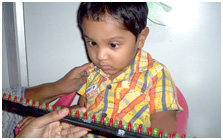
Vision stimulation
Encouraging the use of vision is vital for children with low vision as it enhances their development, education and experiences. Vision stimulation exercise can help children use their remaining vision more effectively. The idea is that by performing these activities, the visual areas of the brain are stimulated to maximise the development of vision.
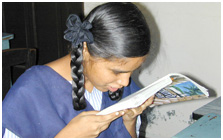
Educational guidance
Finding appropriate educational opportunities for visually impaired children can be quite a challenging task. The counsellor plays an important role to find out the appropriate educational mode for the children with visual impairment.
Vocational guidance
The rehabilitation counsellor assists the person with visual impairment in finding out a suitable job and guide them to a proper institution for getting the prevocational training and for job placement.
Orientation and mobility
Orientation and Mobility training (O & M) helps a person with visual impairment know where he is in space (orientation) and helps him be able to carry out a plan to reach a place he wants to go (mobility).
Low vision devices
Many devices can help people with low vision make the most of their remaining vision and to function better and enhance their quality of life. Different devices may be needed for different tasks.Low vision specialist perform a detailed vision analysis by using the LogMar chart. Distant vision is evaluated using telescopes. High-powered spectacle magnifier, hand or stand magnifiers and the electronic devices may be used to evaluate near vision skills, like reading.
High-power spectacle magnifier
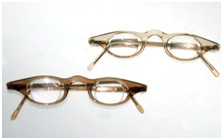
Spectacle magnifiers are stronger than the ordinary power glass. It can be used for near tasks such as reading, threading a needle or any activity that requires close, detailed vision.
Hand magnifier
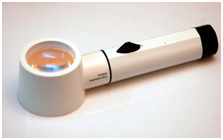
Hand magnifiers are available in varying strengths to suit different people and different tasks.
Stand magnifier
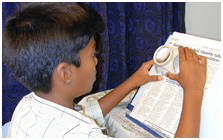
The facility to rest the magnifier over a page is useful for patients with a tremor or arthritis.
Telescope
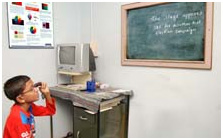
Telescopes are used for seeing far away objects or signs. They can be handheld like a pair of regular binoculars or mounted on a pair of eye glasses. It is mostly useful for children who have problem in seeing the blackboard writings.
Video magnifiers are electronic devices that use a camera and television screen to enlarge printed material, pictures, or small objects. They are adjustable and can enhance the material in different ways. For example, a video magnifier can make the print appear darker (increased contrast).
